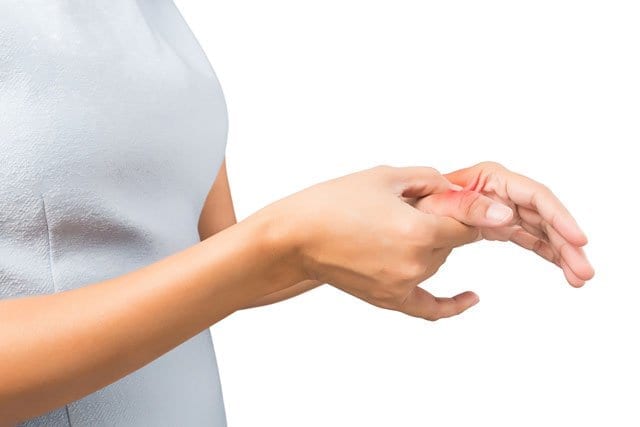How Thumb Joints Work
The joint at the base of the thumb, near the wrist and at the fleshy part of the thumb, enables the thumb to swivel, pivot, and pinch so that you can grip things in your hand.
Smooth cartilage covers the ends of the bones, enabling the bones to glide easily in the joint. Without it, bones rub against each other, causing friction and damage to the bones and the joint. Osteoarthritis occurs when the cartilage begins to wear away.
Symptoms of Thumb Basilar Joint Arthritis
If you think you have thumb basilar joint arthritis the symptoms to look for are pain with activities that involve gripping or pinching, such as turning a key, opening a door, or snapping your fingers. There may be swelling and tenderness at the base of the thumb and an aching discomfort after prolonged use. Many people also experience loss of strength in gripping or pinching activities. They may notice an enlarged, “out-of-joint” appearance or the development of a bony prominence or bump over the joint.
Diagnosis
Your doctor will ask you about your symptoms, any prior injury, pain patterns, or activities that aggravate the condition. One of the tests your doctor will perform during the examination involves holding the joint firmly while moving the thumb. If you have pain or a gritty feeling, or if a grinding sound (crepitus) can be heard, the bones are rubbing directly against each other.
An x-ray may show the deterioration of the joint as well as any bone spurs or calcium deposits that have developed.
Many people with arthritis at the base of the thumb also have symptoms of carpal tunnel syndrome, so your doctor may check for that, as well.
Thumb Joint Arthritis Treatment
In its early stages, arthritis at the base of the thumb will respond to nonsurgical treatment. This includes icing the joint for 5 to 15 minutes several times a day. Anti-inflammatory medications, such as aspirin or ibuprofen, may help reduce inflammation and swelling. Wearing a supportive splint to limit the movement of the thumb allows the joint to rest and heal. The splint may protect both the wrist and the thumb. It can be worn overnight or intermittently during the day.
Because arthritis is a progressive, degenerative disease, the condition may worsen over time. The next phase in treatment involves injecting a steroid solution injection directly into the joint. This will usually provide relief for several months. However, these injections cannot be repeated indefinitely.
When nonsurgical treatment is no longer effective, surgery is an option. The operation can be performed on an outpatient basis, and several different procedures can be used:
- One option involves fusing the bones of the joint together. This, however, will limit movement
- Another option is to remove part of the joint and reconstruct it using either a tendon graft or an artificial substance.
You and your physician will discuss the options and select the one that is best for you.
After surgery, a rehabilitation program, often involving a physical therapist, will help you regain movement and strength in the hand. You may feel some discomfort during the initial stages of the rehabilitation program, but this will diminish over time. Full recovery from surgery can take several months. Most patients are able to resume normal activities.
At Advanced Specialty Care, our skilled team, including surgeons Dr. Sohel Islam and Julia Toto, registered nurses and medical office staff treat a full range of wrist and hand maladies including thumb joint arthritis, carpal tunnel syndrome, Dupuytren’s contractures, finger and nerve injuries, as well as many unsightly conditions such as ganglions, arthritic spurs, protruding veins and skin blemishes. We are located in Danbury, in Fairfield County, Connecticut.
Source: AAOS http://orthoinfo.aaos.org

